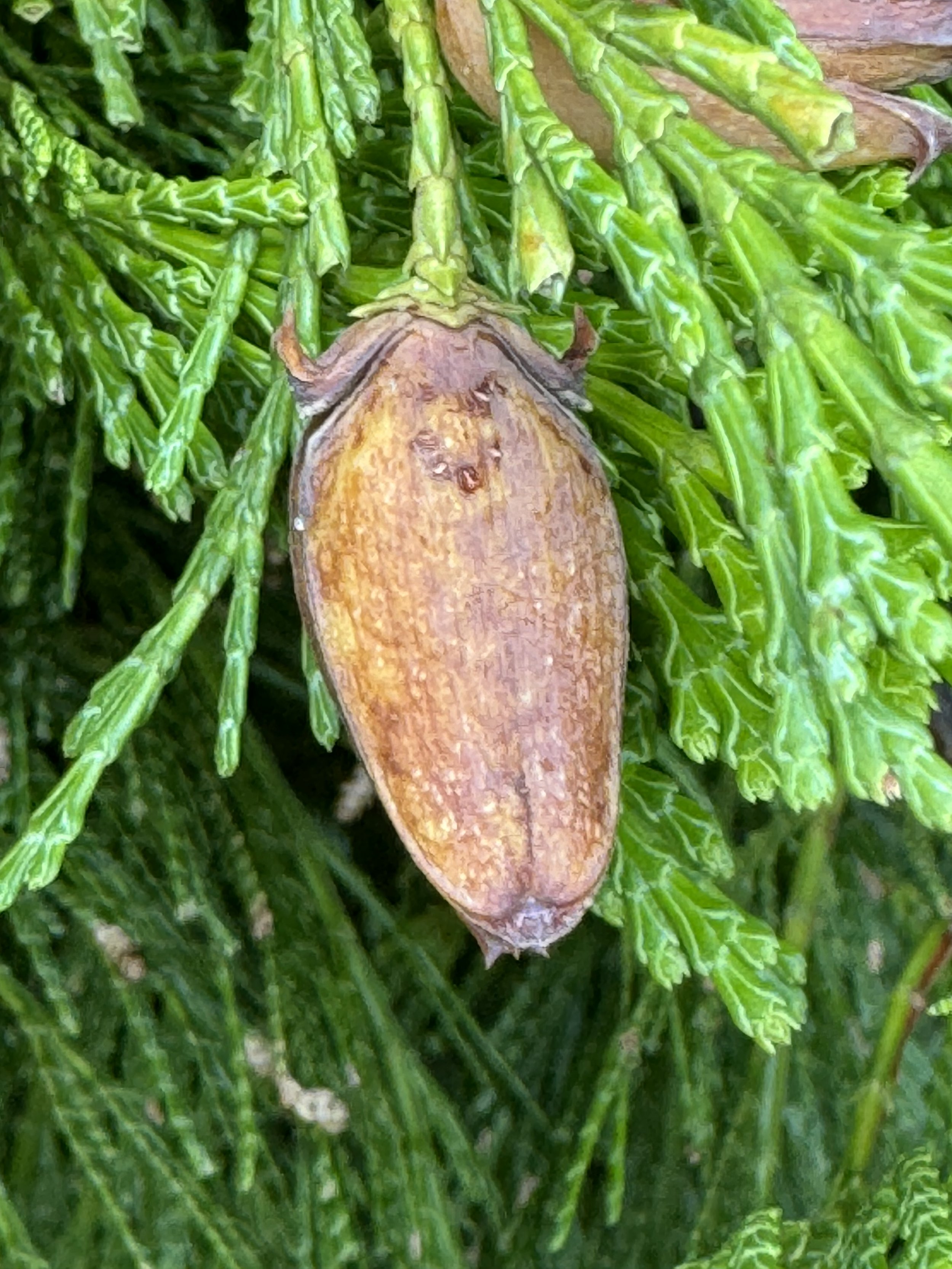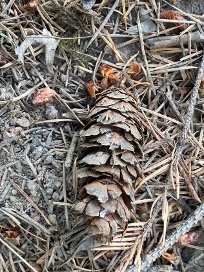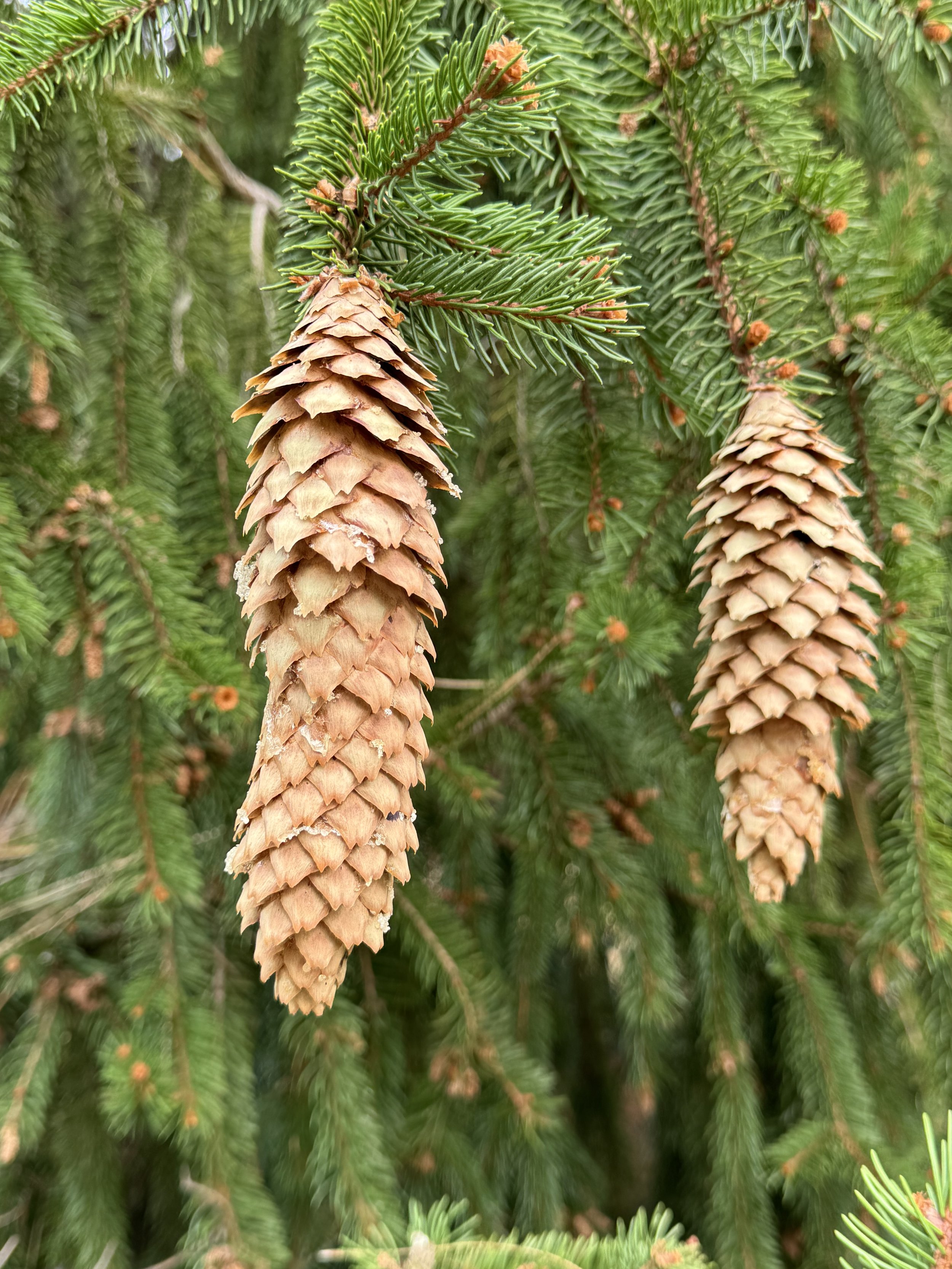Native Conifers
Conifers have needle or scale-like leaves and (usually) have seed-bearing woody cones.
They typically retain their leaves through all seasons of the year.
They are called “softwoods” as their wood is typically softer than other trees’ wood.
Cedar, Incense (Calocedrus decurrents):
Listed as native in: Oregonmetro.gov , portland.gov
Where to find them:
In Bridlemile, Incense Cedar trees are here and there, but one has to look to find them. For example, one grows a few feet off Julia Street. Others are off the north side of the Beaverton-Hillsdale Highway, west of SW Shattuck, in front of an apartment building.
Near Bridlemile,
The mother lode of Incense Cedars is around the parking lot of the Southwest Community Center in Gabriel Park in the Multnomah neighborhood, where one can find 22 Incense Cedars.
A Portland Heritage Incense Cedar: is at 4825 Dosch Park Lane. (Hillsdale neighborhood)'
How to identify Them:
Above: SW Community Center, Multnomah neighborhood. 2024-09-02.
Shape: Incense Cedar is more bushy than of other conifers (photo above). Older trees have a twisted, rumpled appearance. Younger trees in the open have a more pyramidal appearance. Upswept, short branches.
Above: North of Beaverton-Hillsdale Highway, 2024-09-02.
Leaves: A distinct feature of Incense Cedars is how their scale-like leaves are longer than wide. They have been described as having a shape similar to a long-stemmed wine glass. The leaves are flattened and scale-like.
Above: North of Beaverton-Hillsdale Highway, 2024-09-02.
Bark: An easy way to distinguish Incense Cedar from Western Red Cedar is by looking at the bark. Incense Cedar’s bark is flakey. It gets furrowed and reddish brown with age.. In contrast, Western Red Cedar’s bark appears as long thin strips.
Left above: SW Community Center, Hayhurst neighborhood. 2024-09-02.
Right above: SW Community Center, Hayhurst neighborhood. 2024-10-12.
Cones: 2 to 3 cm (~1 inch) (female) are also distinct. Unopened (above left), shaped like a duck’s bill. When open (above right), supposedly look like a flying goose.
Height: Can reach ~35 m (~115 feet).
Miscellaneous facts: Name comes from its fragrant timber. An important commercial use is as a material for use in pencil manufacture.
Native Indians used incense cedars to create baskets and bows.
Cedar, Western Red (Thuja plicata)
Listed as native in: Oregon.gov , Oregonmetro.gov
Where to find them:
Common. They are all over Bridlemile. Both Albert Kelly Park and Hamilton Park have examples.
Since Western Red Cedar are shade tolerant, look for them in shady areas. Also, they like moist areas, like near streams. They mix with Douglas-fir, Western Hemlock, Red Alder and other species.
How to recognize them:
Above: Bridlemile yard, 2024-05.
Leaves: Scalelike, green leaves are distinct in how they are irregular, flat and lacy. They look green when viewed from above and display a white or yellow-ish pattern when viewed from below. The scales look braided when viewed close-up.
Above: Albert Kelly Park. 2024-08-23.
The base (bottom trunk) of the tree swells compared to the rest of the tree.
Above: Bridlemile yard, 2024-05.
Bark: The bark has distinct reddish-brown, stringy, hairy strips, which one can tear off. The bark is shiny on younger trees. Also, the bark has shallow tissues.
Above: Bridlemile yard. 2024-08-23.
Cones (female): The cones look distinct in how they both sit up on branches and bend backwards. Also, before opening, they resemble in shape the bowl of a smoker’s pipe. After opening, they look like tiny rose buds. The cones are slender, small (up to 1 cm (0.75 inches), and have 10 to 12 scales. They have a hooked tip. They mature in August. The seeds are dispersed from September to November.
Height: 60 m (200 feet).
Miscellaneous facts: Because of its reputation for being resistant to decay, it is used for outdoor structures like shingles, sidings, decks and boats.
Northwest Indians used Western Red Cedar logs to make canoes and lodges. They used the bark strips to make clothes, baskets and fishing nets.
Fir, Douglas (Pseudotsuga menziesii):
Listed as native in: Oregon.gov , Oregonmetro.gov , portland.gov
Where to find them:
All over. They are the most common conifer in the Portland area, as well as in the northwest. About 80% of Oregon conifers west of the Cascades are Douglas-firs.
Hamilton Park has many examples in the higher and more natural eastern edge of the park. Dozens grow in Albert Kelly Park, south of SW Stonebrook Drive.
How to recognize them:
Left: Albert Kelly Park. 2024-05-31.
Right: Hamilton Park. 2024-05-28
Cones: The most distinct, easy-to-recognize feature is the 3-pointed, papery bracts between the scales of the cones. Also, the cones hang down below their adjoining branches – and they stay intact when they fall from the tree. Cones are 2” to 4”. When young, green. When older, red-brown.
Mature Douglas-fir bark. Hamilton Park. 2024-05-28.
Bark is another easy-to-recognize feature. Mature trees have a more deeply furrowed/thick/fissured bark than other NW trees. The thickness helps protect the trees from forest fires. Young trees’ bark is smooth. Resin-blistered.
Above: Albert Kelly Park. 2024-08.
Needles: Relatively long and blunt needles (2 to 3 cm (1 to 1.5 inches)) appear in all directions around a twig like bristles around a bottle brush. Dual lines of white dots are on the needles’ undersides. The needles tend to be flat. For much of the year (7 or 8 months), they have relatively long and pointed, reddish-brown buds at the end of the branches. If you crush the needles, you may notice a smell like citronella candles.
Shape: Asymmetrical. The main branches reach out in irregular whorls. Limbs tend to sweep upwards in a droopy way, but can go in all directions, especially as they grow older. Mature trees typically have long, branch-free trunks and short, flat-topped crowns.
Mature trees also typically have long, branch-free trunks. This helps the tree survive forest fires.
Height: Tallest conifer in the NW. Up to 60 to 75 m (200 to 250 feet) – or more.
Age: Douglas-firs typically live 500 years. Some are still doing well at over 1,000 years.
Above: Tree stump of a Bridlemile Douglas-fir that fell down in the 2024-01 ice storm. It had around 127 rings, meaning it had been here since about 1897.
Miscellaneous facts: It is the most important commercial timber tree. Its strength and straightness make it a useful structural material. Also, it is the most popular Christmas tree in USA.
The pollen record shows that Douglas-fir only became widespread in the area west of the Cascades around 12,000 years ago – i.e. after the ice age.
Fir, Grand (Abies grandis)
Listed as native in: Oregonmetro.gov , portland.gov
Where to find them:
In Bridlemile: Albert Kelly Park, along Restoration Creek.
Multiple non-park areas including SW Beaverton-Hillsdale Highway (near intersection with SW Olson Road) and residential front yards.
Near Bridlemile: The Portland Tree Inventory shows one in Hillsdale Park next to Robert Gray School.
Hoyt Arboretum has an even larger one.
Not too plentiful. Grand Firs account for just 2% of NW conifers.
Try looking in moist locations, such as near a stream.
How to recognize them:
Above: Beaverton-Hillsdale Highway, near Olson Road intersection. 2024-06.
Shape is Christmas-tree like when younger (photo above). From a distance, in general, fir trees look symmetrical. Tall tree, which typically can grow to 40 m (130 feet) high. Lower branches droop and have upturned tips. Grand Fir branches are opposite and usually level.
Above: Albert Kelly Park. 2024-06-03.
Needles on the lower branches grow in two flat opposing rows (photo above). However, in bright light, they may form a V shape. Lines of white dots appear on the undersides. Soft with blunt, not sharp, notched ends. Waxy, deep green on top and silver below.
Grand Fir needles are similar in length to Douglas-fir needles. However, Grand Firs have round buds, while Douglas-firs have pointed ones.
Fir needles are flat and not easy to roll between one’s fingers. Spruce needles are four-sided and tend to easily roll between one’s fingers, although they may go clunk, clunk, clunk….
Above: Grand Fir bark. SW Julia Street. 2024-06-02.
Bark: 5 cm (2 inches) thick. When young: smooth, shiny, grayish-brown, with resin blisters and white blotches. When older: deeper brown, thick, cracked, and scaly, with dark gray, flat ridges (photo above).
Grand Fir cones grow upright on branches (like candles), while Douglas-firs and spruce cones hang downwards. Grand Fir ones fall apart when mature and leave pencil-like spikes on branches. They are unlikely to be intact when on the ground.
Miscellaneous: Its shape and smell make it a popular Christmas tree.
Hemlock, Western (Tsuga heterophylla)
Listed as native in: Oregonmetro.gov , portland.gov
Where to find them:
In Bridlemile: A few front yards. Not many. They were likely much more prevalent before the post-WW2 housing boom.
Near Bridlemile: Hoyt Arboretum.
Western Hemlocks prefer low to middle elevations and can grow in shade tolerant conditions, such as under other trees.
In NW forests, Western Hemlocks root on decaying wood nurse logs in the understory.
How to recognize them:
Above: Bridlemile yard, 2024-06-17.
Shape: The most distinctive feature when seen from a distance is the thin, droopy top branch (leader) up at the crown (above photo). It frequently points away from the prevailing wind. The lower branches droop. The lower trunk is typically branch free. The overall shape can either be tall and straight or twisted and curved.
The foliage is typically narrow at the crown and spreads out towards the bottom. It has a messy “bad haircut” shape.
Above: Hoyt Arboretum. 2024-05.
Needles. A distinct Western Hemlock feature when viewed from close up is the overall average shortness of the needles, and their three different lengths. They are generally of a 1) shorter, 2) medium, or a 3) longer length. On average, they have the shortest needles of any NW conifer (1.25 cm (0.5 inches)).
They grow every which way – in contrast to the more organized needle arrangements on other conifers, such as Grand Firs. They grow towards the end of each branch. Flat-looking. Rounded tips at the ends.
They are green and looking-waxy on the top side. Lines of white dots (somata) are on the lower surface.
Above: Hoyt Arboretum. 2024-05.
Cones: Small at 3 cm ( ~1 inch) long. Oval/egg-shaped. Few rounded, smooth scales. The fall all over the forest floor.
Above: Hoyt Arboretum. 2024-05.
Bark: The bark is thin (2.5 cm (1 inch)) and reddish-brown to grey. When the tree is young, the bark is smooth. When the tree is older, the bark furrows with flat-topped, vertical scaly ridges.
Miscellaneous facts: It is shade tolerant, so it can be an under-study tree.
Its wood is used commercially in lower-strength construction as pallets, crates, plywood, framing, etc. It is used to make high-quality paper, cellophane, rayon and plastics. Gym floors.
It is the state tree of Washington.
Pine, Ponderosa (Willamette Valley) (Pinus ponderosa)
Where to find them:
Listed as native in Oregon.gov, Oregonmetro.gov , portland.gov
A Portland Heritage Tree is at 4504 SW Shattuck Road (Tigard-Rogers House at the corner of SW Shattuck and SW Hamilton). It is listed with the following: Height: 26 m (85 feet), spread: 1.2 m (4 feet), Circumference: 5.3 m (17.4 feet). It is one of five Ponderosa Pine Heritage Trees in Southwest Portland.
The Portland Tree inventory shows 12 Ponderosa Pines at Albert Kelly Park.
Try looking in sunny places.
How to recognize them:
Above: Albert Kelly Park. 2024-06.
Needles are distinctively long (10 to 28 cm (4 to 11 inches)) and emerge from a sheath in bundles of three (a cluster of pine needles is called a “fascicle”). They are the only native NW tree with needles that come in bundles of three.
In addition, they are straight, stiff, sharp and bunched at the ends of branches.
Left: Ponderosa Pine bark (Tigard-Rogers house yard, 2024-09-18).
Middle: Ponderosa Pine bark (Tigard-Rogers house yard, 2024-06-02).
Right: Ponderosa Pine bark (Tigard-Rogers house yard, Victor Von Salsa. (early 2000’s?).
Bark: Another distinct feature is the thick pumpkin/orangey-colored bark on mature trees. It can be deeply furrowed Also, it flakes off in large, jigsaw puzzle-like plates. The thick bark helps the tree survive forest fires.
The bark of young trees is nearly black.
Left: Albert Kelly Park. 2024-06. Right: Tigard-Rogers House yard, Victor von Salza. Early 2000’s?
Shape: Straight trunk. Often branch-free for lower part. From a distance, pine trees in general look less symmetrical than other conifers. They tend to stand out on their own, rather than to share sunlight with other trees.
Above: Albert Kelly Park. 2024-06-13.
Their cones are distinct by their large size (3 to 5 inches), “woody” appearance, and sharp points at the ends of scales. Also, they are egg-shaped. Ponderosa Pine cones.
Miscellaneous facts: Ponderosa Pine is important commercial lumber for residential construction, furniture and millwork.
In nature, Ponderosa Pine seeds and popular with many birds (e.g. chickadees, nuthatches, sparrows, towhees) and animals (chipmunks, squirrels, mice, and beavers).
Spruce, Sitka (Picea sitchensis)
Listed as native in: Oregonmetro.gov
Where to find them:
In Bridlemile, one can find them in multiple yards. However, they are not apparent in local parks.
Outside Bridlemile, they are plentiful on the Pacific coast from Oregon up to Alaska.
How to recognize them:
Above: Bridlemile front yard, SW Hamilton Street. 2024-06-17.
From below, an optical illusion makes Sitka needles look bluish. Actually, they have a green background and 2 or 3 lines of white dots (stomata). This green and white combination. makes them look bluish.
Above: Across the street from Albert Kelly Park, 09-01-2024.
Needles: A distinctive feature are the sharp-pointed needles. As a result, they are known as “the un-friendly needles”. Good advice is to never shake hands with Sitka Spruce needles because of their sharpness. Also, they are dense foliage, which sticks out around each twig like a bottle brush. 2 to 3 cm (~1 inch).
Also, the needles have a distinct color marking. Front above, they have lush, dark green appearance.
Above: Across the street from Albert Kelly Park. 2024-09-01.
Bark: When the tree is young, the bark is smooth. When older, a distinct feature is that the bark can flake off as 5 to 20 cm (2 to 8 inch) large, loose, reddish-brown scales.
Left photo of Sitka Spruce cone on ground is from across the street from Albert Kelly park. 2024-08-26.
Right photo of cones hanging down is from Bridlemile yard. 2024-09-07.
Cones: 5 to 10 cm (2 ½ to 4 in). ~3”. Yellowish to reddish brown. Oblong cylindrical. Thin, paper-like scales. They tend to be easy to find as they typically litter the ground under the tree.
Above: Across the street from Albert Kelly park. 2024-09-01.
Shape: Main branches go out horizontally. In shape, in areas with less snow, they tend to have a Christmas tree shape. In areas with more snow, they tend to grow with a more narrow shape.
Crown: When young, broad conic. When older, cylindric.
Height: Tall - Up to 55 m (180 feet) or more. And they are long-lived – up to 700 years old.
Branches: Old trees may not have branches lower than 30 to 40 m (98 to 131 feet).
Miscellaneous: Commercial uses: Sitka Spruce’s high strength to weight ratio made it useful for building WWI and WWII airplanes. The same ratio makes it a useful source for garage doors. Its resonant quality makes it useful for making music instruments (e.g. pianos and violins). Its long fibers makes it valuable as a source for paper making.
Yew, Pacific (Taxus brevifolia)
Listed as native in: Oregonmetro.gov , portland.gov
Where to find them:
In Bridlemile, on rare front yards.
Near Bridlemile, examples are in Hoyt Arboretum, Laurelhurst Park. Tryon Creek Park.
Look in moist, shady places. Usually forested areas and sometimes in yards, it is an understory tree, beneath Douglas-firs or western hemlocks. Lacks a distinct form. Branches grow towards available light.
How to recognize them:
Above left, Bridlemile front yard, 2024-06-04: Needles are a distinct feature. They have distinct points. Opposite. 1 to 2.5 cm (Up to 1”). Needle topside: Dark yellowish-green. Needle bottomside: Paler green. Short, broad, flat with soft tips. Glossy. Spread out on in two flat rows on opposite sides of each twig.
Above middle: Bridlemile front yard. 2024-09-01. Bark/trunk has a contoured trunk with red to purplish-brown outer scales.
Above right: Bridlemile front yard. 2024-09-01. Fruit (aka “aril”) (right photo) is a berry-like, fleshy pulp that surrounds a poisonous seed. Birds eat them. Female plant feature.
Shape: Small, branchy tree.
Height: Up to 15 m (~50 feet).
It is shade tolerant, which allows it to thrive as an understory tree.
Miscellaneous; Bark contains the cancer-fighting chemical Taxol. The woods’ resilience makes it useful as a bow or a paddle. Its durability in soil makes it useful for fence posts.
Sources of information:
Brewer, Karen. Northwest Know-How: Trees. Sasquatch Books. Seattle, Wa. 2021.
Jensen, Edward, C. Trees to Know in Oregon and Washington. Oregon State Extension Service. Corvallis, Oregon. 2020.
Kriegh, LeeAnn. Nature of Portland. Tempo Press. Bend, Oregon. 2020.
Portland Tree Inventory
Rushforth, Keith and Hollis, Charles. Field Guide to the Trees of North America. National Geographic. Washington DC.
Wikipedia.org.







































